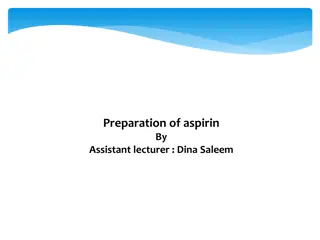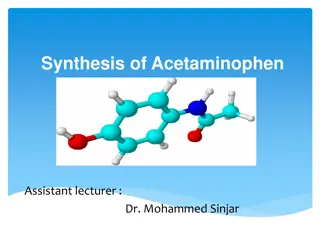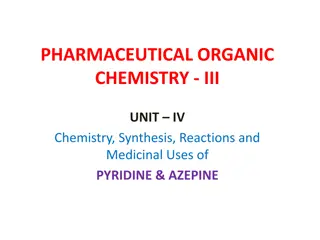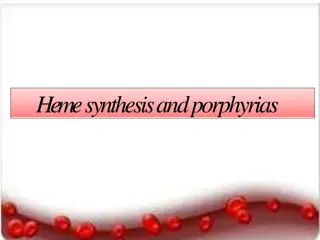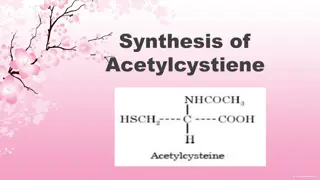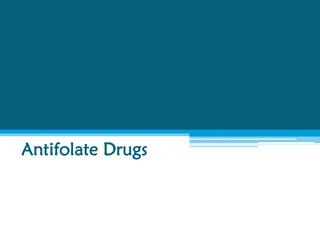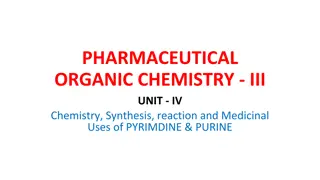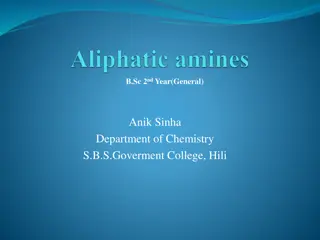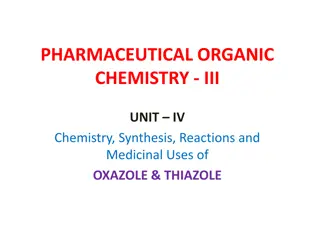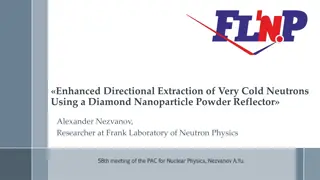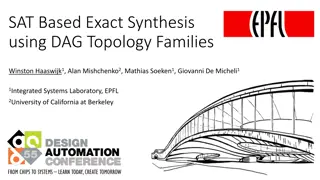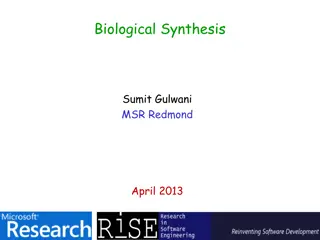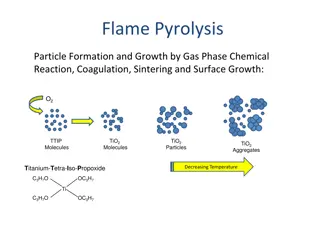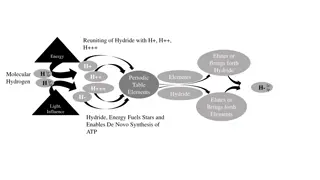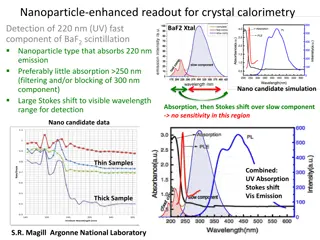Innovative Approaches to Nanoparticle Synthesis
Various physical and chemical methods have been used for the synthesis of organic metal nanoparticles, but they come with drawbacks such as high energy requirements, waste disposal issues, and toxic by-products. To address these challenges, there is a push for environmentally friendly methods using biological resources from nature. Microscopic agents like bacteria and fungi, as well as macroscopic sources such as algae and plant extracts, are being explored. Different synthesis methods are categorized based on whether they follow a bottom-up approach, where smaller components self-assemble to form larger structures. Self-assembly, a key fabrication tool in nature, involves the spontaneous organization of sub-units into stable structures through non-covalent interactions. Embracing cleaner, biocompatible, and cost-effective methods is essential for the sustainable synthesis of nanoparticles.
Download Presentation

Please find below an Image/Link to download the presentation.
The content on the website is provided AS IS for your information and personal use only. It may not be sold, licensed, or shared on other websites without obtaining consent from the author.If you encounter any issues during the download, it is possible that the publisher has removed the file from their server.
You are allowed to download the files provided on this website for personal or commercial use, subject to the condition that they are used lawfully. All files are the property of their respective owners.
The content on the website is provided AS IS for your information and personal use only. It may not be sold, licensed, or shared on other websites without obtaining consent from the author.
E N D
Presentation Transcript
PHYSICAL AND CHEMICAL METHODS Various physical and chemical processes have been exploited in the synthesis of several organic metal nanoparticles. -The high energy requirement in physical methods of nanoparticle synthesis. -and the waste disposal problems in chemical synthesis, -so both methods are costly. -and generate toxic by product are major demerits of the conventional nanoparticle synthesis. by Dr.Neihaya Heikmat
Accordingly, there is a necessary need to extend for environmentally benign procedures for synthesis of nanoparticles. A promising move towards to reach this objective is to develop the array of biological resources in nature. by Dr.Neihaya Heikmat
Such drawbacks demand the development of clean, biocompatible, nonhazardous, inexpensive, energy-efficient, and eco-friendly methods for nanoparticles synthesis.
Microscopic agent: Bacteria, Fungi Actinomycetes. Macroscopic: Algae, Sea weeds, Plant Extracts (Leaves, Bark, Stem, Shoots, Seeds, Latex, Secondary metabolites, Roots, Twigs, peel, fruit, seedlings, essential oils, Tissue cultures, Gum).
methods can be classified according to whether their assembly followed either: i) Bottom-up approach, where smaller components of atomic or molecular dimensions self-assemble together, according to a natural physical principle or an externally applied driving force, to give rise to larger and more organized systems;
Self-assembly is the fabrication tool of nature: all natural materials, organic and inorganic, are produced through a self- assembly route to create complex structures with nanoscale precision. Examples are the formation of the DNA double helix or the formation of the membrane cell from phospholipids.
In self-assembly, sub-units spontaneously organize and aggregate into stable, well-defined structures through non-covalent interaction.
ii) the top-down approach, a process that starts from a large piece and subsequently uses finer and finer tools for creating correspondingly smaller structures.
phytonanotechnology has provided new avenues for the synthesis of nanoparticles and is an: ecofriendly, simple, rapid, stable, and cost-effective method.
Phytonanotechnology has advantages, including: biocompatibility, Scalability, and the medical applicability of synthesizing nanoparticles using the universal solvent, water, as a reducing medium.
The exact mechanism and the components responsible for plant- mediated synthetic nanoparticles remain to be elucidated. It has been proposed that proteins, amino acids, organic acid, vitamins, as well as secondary metabolites, such as:
flavonoids, alkaloids, polyphenols, terpenoids, heterocyclic compounds, and polysaccharides, have significant roles in metal salt reduction and, furthermore, act as capping and stabilizing agents for synthesized nanoparticles.
Reports also suggest that different mechanisms for synthesizing nanoparticles exist in different plant species.
The reduction method using plant extracts is one step, low cost and eco-friendly, hence considered as the most preferred way for the synthesis of metal nanoparticles. Thus, this method may be included in the class of green technology.
various plant parts, including leaves, fruits, stems, roots, and their extracts, have been used for the synthesis of metal nanoparticles.
Among various nanometals explored so far, nanoparticles of silver, gold, copper, zinc, palladium, titanium, nickel, indium etc. have been prepared by using a wide variety of plant extracts.
EXTRACTION FROM PLANT PLANT EXTRACT PLANT NANOPARTICLE RECOVERY EXTRACT AND METAL SOLUTION STIRRING
The leaves of plants like Mentha, Ocimum, and Eucalyptus were reported for the synthesis of gold nanoparticles. Ocimum leaf provided finer particles compared with other plant leaves used. The polymorphic gold nanoparticles synthesis was reported from Citrus limon The gold nanoparticles were polymorphic, stable, size 30 130 nm in non agglomerated form.
The synthesis of silver nanoparticles through seeds of the plant Elaeocarpus granitrus was reported. The nanoparticles were involved for development of bionanocomposite with chitosan matrix and antimicrobial assay was done.
The synthesis of silver nanoparticles was reported using aqueous seed extract of Jatropha curcas. The stable silver nanoparticles at different concentration of AgNO3 were spherical in shape with diameter ranging from 15 to 50 nm.
The synthesis of gold nanoparticles with essential oils extracted from the fresh leaves of Anacardium occidentale was reported. The NPs synthesized at room temperature were hexagonal in shape while at higher temperature were mixture of an isotropic particles.
The biosynthesis of silver nanoparticles (AgNPs) from Citrus sinensis peel extract was reported. The synthesized AgNPs were effective antibacterial agent. The aqueous extracts from the peels of Citrus fruits (orange, grapefruit, tangelo, lemon and lime) were used for the synthesis of AgNPs using microwave technology; the synthesis was successful for the orange peel extract.
The plant broth of Phyllanthus amarus containing secondary metabolites was used for the formation of silver nanoparticles (AgNPs). The coconut water was used for synthesis of gold nanoparticles through microwave irradiation. The nanoparticles were tested for cytotoxicity on two human cancer cell lines, and found to be nontoxic.
The stem extract of Breynia rhamnoides was used for synthesis of gold and silver nanoparticles was reported. The nanoparticles showed antibacterial property against multi-drug resistant bacteria such as Pseudomonas aeruginosa, Escherichia coli, and Staphylococcus aureus.
Tribulus terrestris fruit bodies were used for synthesis of silver nanoparticles. The nanoparticles were spherical shaped with 16-28 nm of size.
The latex of Jatropha curcas was used in silver nanoparticles synthesis. The particles radius was 10 20 nm and stabilized by the cyclic peptides. The latex of Euphorbia milii was used in silver nanoparticles synthesis, and sizes were of 10 50 nm .
The extracts from tissue culture-derived callus and leaf of the salt marsh plant (Sesuvium portulacastrum L.) used in the synthesis of silver nanoparticles. The callus extract was able to produce antimicrobial silver nanoparticles than leaf extract. The silver nanoparticles synthesized were spherical in shape with size 5 to 20 nm.


